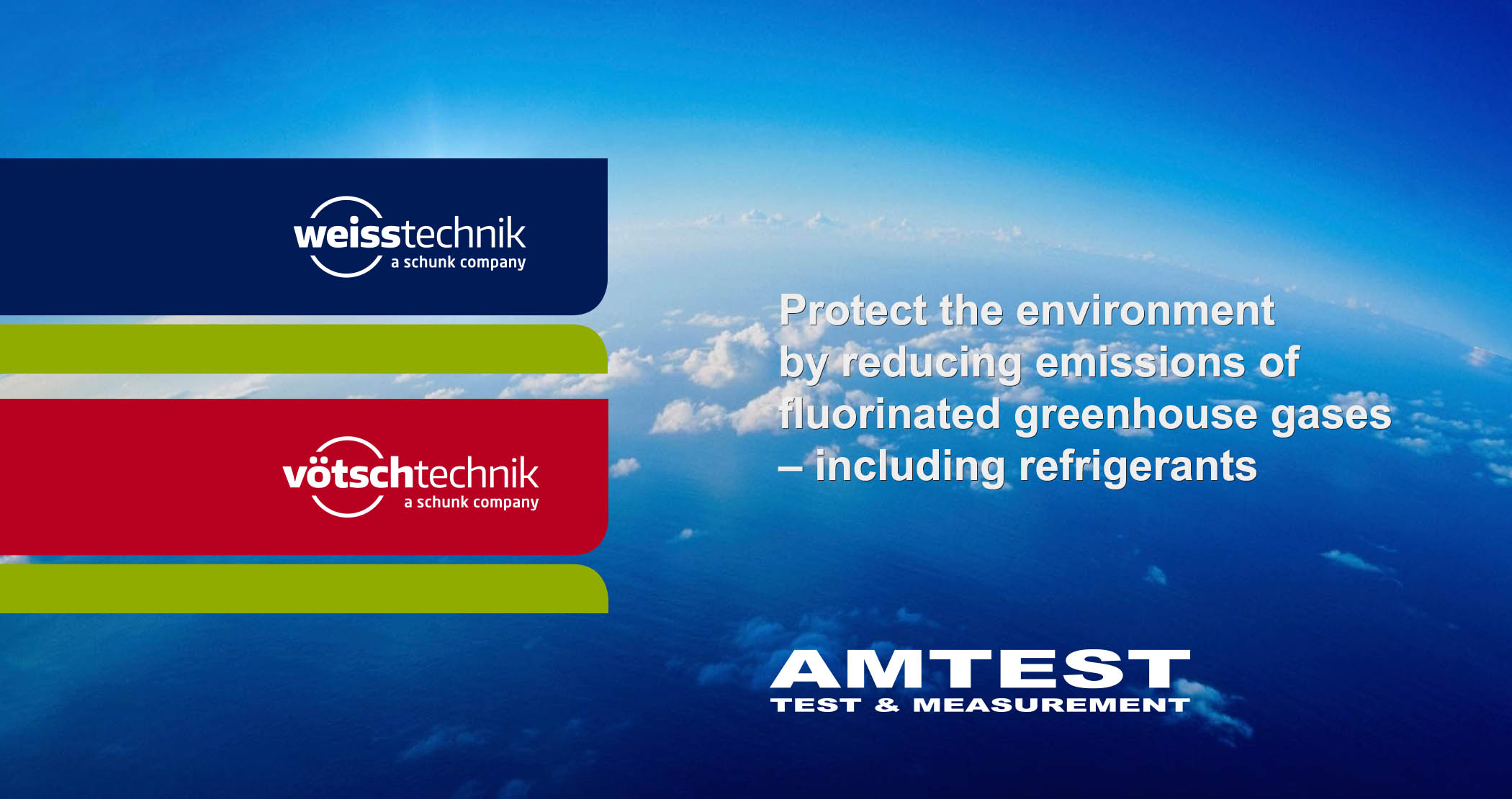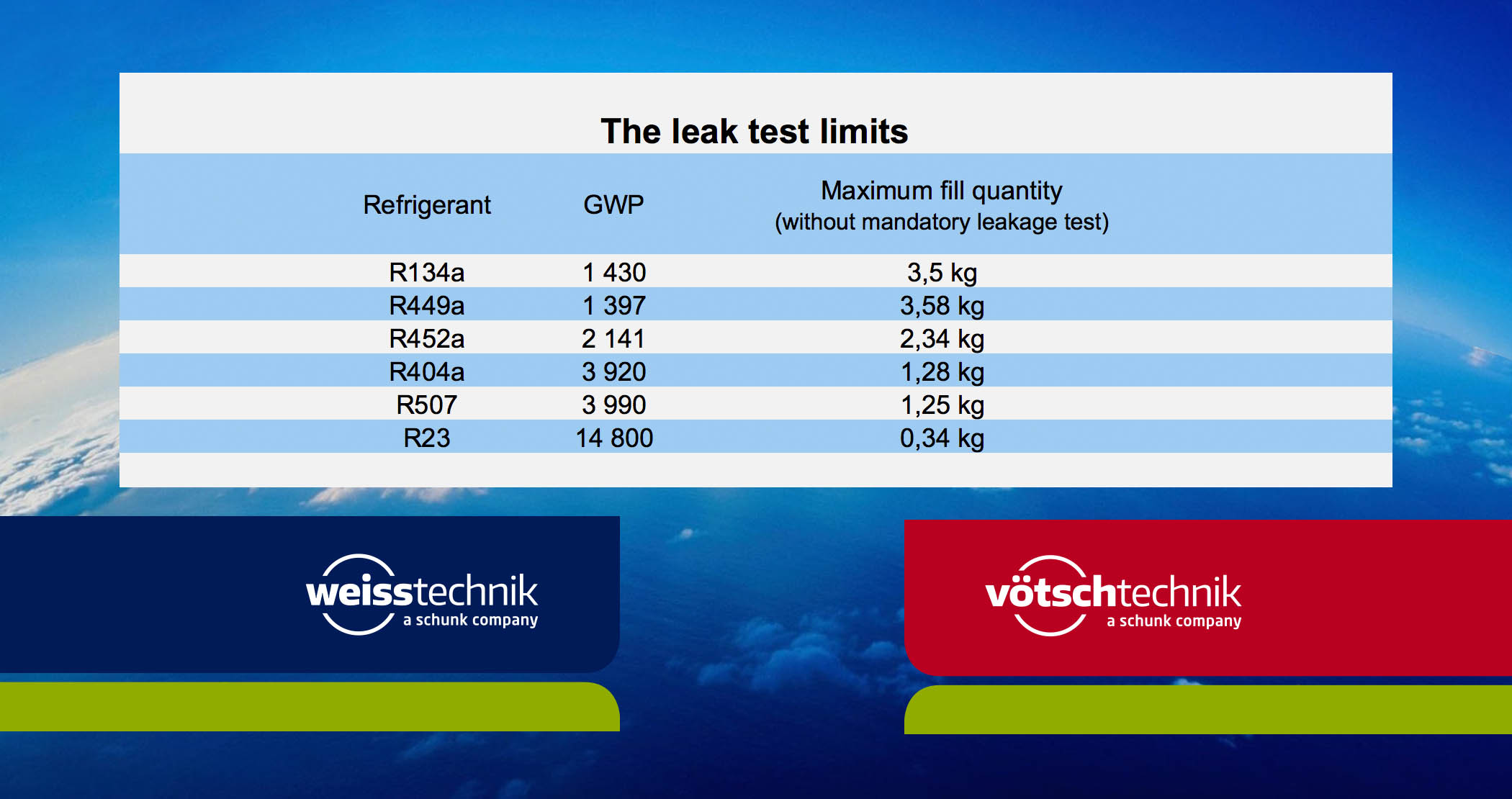Regulation of fluorinated greenhouse gases (EU) No. 517/2014
Document of fluorinated greenhouse gases (EU) No. 517/2014 provides information on the contents of the Regulation, its impact on operators and our current activities and recommended action.

Impacts and analyses of Regulation (EU) No 517/2014
Regulation (EU) No 517/2014, also known as F-gas Regulation, entered into force Europe-wide on 1 January 2015. Our climate chambers use gases that are subject to this Regulation.
GENERAL POINTS
1. What is the F-gas Regulation?
"The objective of this Regulations is to protect the environment by reducing emissions of fluorinated greenhouse gases (including refrigerants).
Accordingly, this Regulation:
a) establishes rules on containment, use, recovery and destruction of fluorinated greenhouse gases, and on related ancillary measures;
b) imposes conditions on the placing on the market of specific products and equipment that contain, or whose functioning relies upon, fluorinated greenhouse gases,
c) imposes conditions on specific uses of fluorinated greenhouse gases, and
d) establishes quantitative limits for the placing on the market of hydrofluorocarbons.*"
2. Why are climate chamber operators affected?
Climate chambers are cooled by refrigerants which consist of hydrofluorocarbons and are thus subject to the F-gas Regulation. As an operator of such a system, you are legally obliged to implement the Regulation in a technically correct manner.
3. Which refrigerants are affected?
The Regulation contains a classification system that specifies which refrigerants must be replaced due to their potentially detrimental properties. In the case of environmental simulation systems, this predominantly refers to R404A and R507.
Thanks to an exemption in the field of environmental simulation, R23, which is also used, is not affected (see 4.). R134a, which is used to some extent, is also exempted from the Regulation.
4. What relevance does the GWP value have?
To determine the harmfulness of refrigerants, they are compared to the greenhouse gas CO2. The resulting value, which is referred to as GWP (Global Warming Potential), indicates the factor by which the substance's potential effect on global warming is higher than that of CO2. This is referred to as the CO2 equivalent.
For example: R404A has a GWP of ≈ 3,900, i.e. one kilogram of R404A that is released into the atmosphere has the equivalent harmful effect of ≈ 3,900 kg CO2.
* hydrofluorocarbons: Article 1 Chapter 1 of Regulation (EU) No 517/2014 of the European Parliament and the Council of 16 April 2014
5. From which date onwards will the Regulation affect operators?
- 1 Jan. 2015: Regulation enters into force
- 1 Jan 2017: Amendment of leakage test limits Mandatory identification of refrigerants in systems
- 1 Jan 2020: New systems may no longer be filed with gases with GWP ≥ 2,500
- 1 Jan 2020: Regulation of service and maintanance of systems with F-gases (GWP ≥ 2,500) CO2 eq. > 40t (recycled/fresh)
- 2030: General prohibition ( including service and maintenance) of refrigerants with a GWP ≥ 2,500
As of 1 January 2017
All new and existing systems are subject to the amended regulations for leakage tests. Depending on the CO2 equivalent of the respective refrigerant, leakage tests may be mandatory with immediate effect – even in the case of smaller fill quantities. The following table shows the limits above which leakage tests will be mandatory in the future:
All new and existing systems with refrigerant volumes above the forenamed limits must be tested for leak tightness at regular intervals.
As of 1 January 2020
Refrigerants in new systems may not exceed a GWP of 2,500. Regulation (EU) No 517/2014 does not specify any limits regarding the fill quantity. Devices and systems that generate test chamber temperatures below -50 °C are exempted; these systems generally use the refrigerant R23 which is not covered by the Regulation.
Existing systems may continue to operate after 2020, irrespective of the refrigerant used. The exception are systems that use R404A in a fill quantity above 10 kg: When serviced, they must be refilled with recycled R404A.
Until 31 Dec. 2030
Existing systems using 10 kg or less of refrigerant R404A may be refilled with fresh, i.e. new R404A when they are serviced.
As of 1 January 2030
Existing systems must be changed over to an alternative refrigerant when they are serviced.
6. Are operators obliged to carry out additional leakage tests?
As explained under 5, all systems that exceed a certain fill quantity are affected. Operators are responsible for commissioning and/or performing the leakage test. Depending on the refrigerant quantity, the test cycle may range between 3 and 12 months. Where automatic leakage systems are used, the intervals are twice as long. Leak tightness tests must be carried out at or above the following refrigerant quantities:

7. Can automatic leakage monitoring help?
Leakage monitoring of cooling devices prevents undetected effluence of refrigerants and indicates leakages at an early stage. On principle, the installation of leakage monitoring systems does not replace leakage tests. However, the prescribed test cycle can be extended to twice its length.
8. What other formal consequences are there for operators?
Operators of refrigeration systems are required to have a comprehensive chain of evidence for the quantity of purchased refrigerant and its use. This comprises the duty to hold evidence and documentation regarding the entire life cycle of the system. One way of ensuring such documentation is the weisstechnik® log book which we provide free of charge.
REFRIGERANTS BY WEISSTECHNIK®
1. How much refrigerant is used in weisstechnik® systems?
New systems: The refrigerant quantity, the GWP and the CO2 equivalent are all specified in the technical documentation of the respective system. Please do not hesitate to ask your contact at weisstechnik® for further information regarding the refrigerant quantity.
Existing systems: Information regarding the refrigerant quantity is specified on the system's identification plate.
On top of this, you can find the quantity used in the system's technical documentation which is included in the delivery. Should you not be in possession of the technical documentation, please request a copy from your contact at weisstechnik®.
2. Our alternatives to R404A
a) Existing systems: R452A (GWP of 2,141)
R452A was developed as an alternative for low temperature applications and is below the required GWP limit. Its thermodynamic properties largely correspond to R404A. As regards all weisstechnik® systems, R452A is suitable as a direct replacement (so-called drop-in).
Similar to R404A, R452A is neither flammable nor toxic. Changes in the safety review are thus not necessary either for existing or for new systems.
b) New systems including and after ClimeEvent: R449A (GWP 1,397)
Its very low GWP makes R449A the first choice as substitute refrigerant in weisstechnik®'s forwardlooking strategy. However, since the thermodynamic performance figures deviate from R404A, adjustments of the refrigeration technology are necessary to guarantee the systems' extensive performance range. The use of R449A is thus expedient in new systems only.
Again, R449A is neither flammable nor toxic. Changes in the safety review are thus not necessary either for existing or for new systems.
3. Do the alternative refrigerants have any disadvantages?
Due to their low market spread, alternative refrigerants currently have a higher purchase price. However, in the course of the Europe-wide conversion to the new refrigerants, prices will assimilate.
The performance parameters of the new alternative refrigerants are different from R404A. To meet the high performance requirements of our systems, adjustments of the refrigeration technology are necessary. These adjustments have been tested in great detail over the last few years, both in internal and in field tests. There will be no loss of performance.
The new alternative refrigerants meet the published performance parameters of the weisstechnik® systems.
